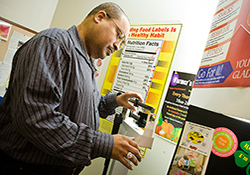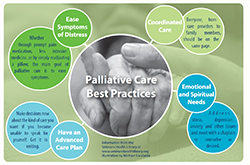Office of Research & Development |
 |
Office of Research & Development |
 |


Within VA, about one-third of primary care visits are with physician assistants or nurse practitioners, rather than with physicians. (Photo: ©iStock/FatCamera)
June 4, 2019
By Tristan Horrom
VA Research Communications
The researchers looked at the electronic health records of more than 600,000 Veterans with diabetes.
VA patients with diabetes have similar health outcomes regardless of whether their primary provider is a physician, nurse practitioner (NP), or physician assistant (PA), according to a Durham VA Health Care System study.
The results appear in the June 2019 edition of the Journal of the American Academy of Physician Assistants.

VA enrolling participants for groundbreaking diabetes study

Skype therapy works for low-income, homebound elderly

Pain reduction, via positive psychology and the Web

VA study leads to improved end-of-life care
“Our study found that there were not clinically important differences in intermediate diabetes outcomes for patients with physicians, NPs, or PAs in both the usual and supplemental provider roles, providing additional evidence for the role of NPs and PAs as primary care providers,” said Dr. George Jackson, senior author on the paper. Jackson is a research health scientist with the Center of Innovation to Accelerate Discovery and Practice Transformation (ADAPT) at the Durham VA Medical Center in North Carolina. He is also an associate professor at Duke University.
Demand for primary care services is growing rapidly. This growth is due mainly to an aging population, who have an increasing number of chronic illnesses. The number of Americans older than 65 is expected to double by 2050, bringing with it increased health care needs. More chronic illnesses means increased complexity of the care needed, making it harder for a single clinician to provide all required care.
In response to this demand, health care systems are exploring new models of care delivery. One approach to address this demand is using teams of multiple clinicians to meet patients’ needs. Several years ago, VA instituted Patient Aligned Care Teams (PACTs) as the model for patient care. PACTs involve a team of care providers working together with Veterans to focus on wellness and disease prevention in addition to treatment.
Each PACT is led by either a physician, nurse practitioner (NP), or physician assistant (PA), and any one of those disciplines can also serve as a supplemental provider, supporting the main provider in the PACT. Within VA, about one-third of primary care visits are with PAs or NPs, rather than with physicians. While care teams led by PAs or NPs are becoming more and more common, questions remain about whether patients do as well with non-physicians leading their care.
To answer this question, the researchers turned to a large patient population within VA who often have complex health care needs: those with diabetes. The researchers looked at the electronic health records of more than 600,000 Veterans with diabetes.
A physician was the usual provider for 77% of these patients. The researchers did not find any statistically significant difference in quality of care based on the discipline of either the usual care provider or supplemental care providers. Patients whose usual care provider was a physician had similar health outcomes to those who mostly saw a PA or NP. Whether supplemental primary care providers were physicians or other providers also did not result in clinically important differences in patient outcomes.
For example, compared to physician-only care, patients who saw only PAs in primary care had a 0.06% decrease in in HbA1c (a measure of blood sugar, with lower numbers meaning better diabetes control). Patients who saw NPs only in primary care had 0.06% decrease HbA1c compared to those who saw physicians only. The differences were not large enough to be considered significant, meaning the results across those groups of patients were about equal.
While the researchers acknowledge that some patients may still prefer that their care be overseen by a physician, other studies have shown that patients are generally satisfied with care from NPs or PAs. VA has been guided in part by such past findings in expanding the use of PAs and NPs as team leaders. The fact that PAs and NPs had similar results for quality of care without sharing care with a physician suggests that using these providers in primary care may improve the efficiency of health care service, say the researchers.
VA Research Currents archives || Sign up for VA Research updates